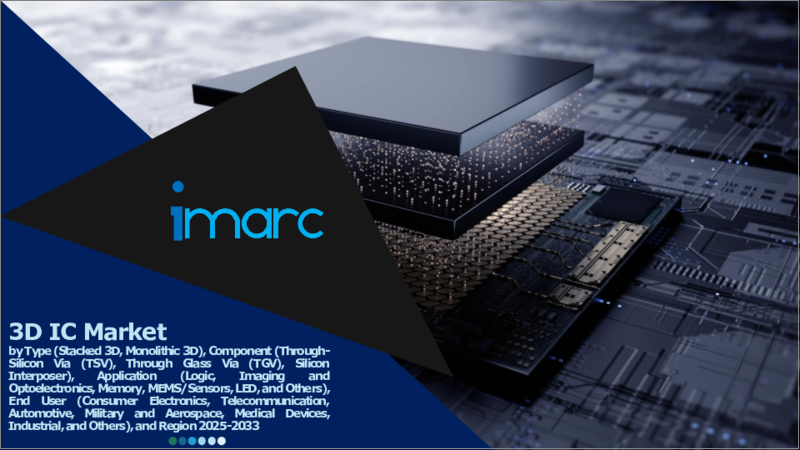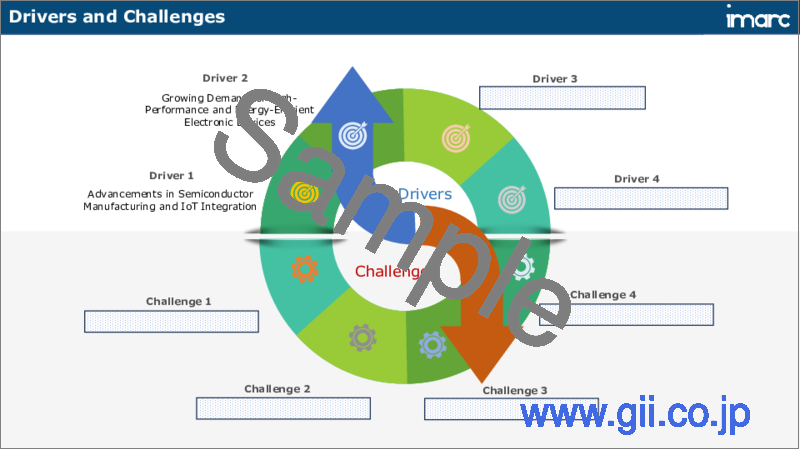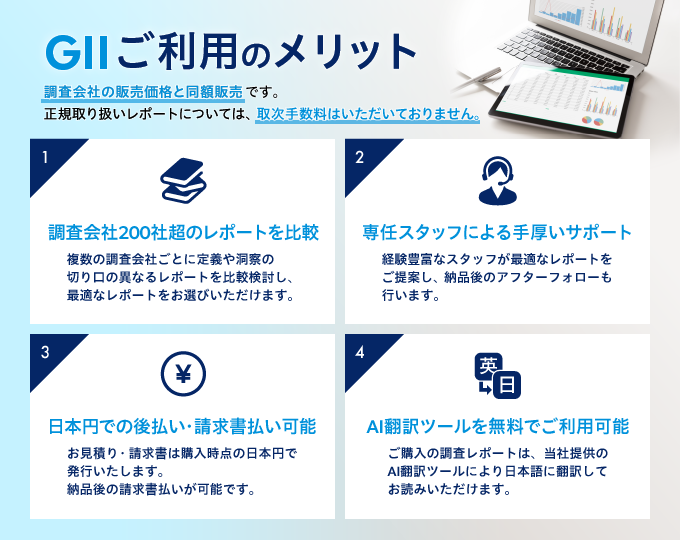|
|
市場調査レポート
商品コード
1635889
3D IC市場:タイプ別、コンポーネント別、アプリケーション別、エンドユーザー別、地域別、2025-2033年3D IC Market by Type, Component (Through-Silicon Via, Through Glass Via, Silicon Interposer), Application, End User, and Region 2025-2033 |
||||||
カスタマイズ可能
|
|||||||
| 3D IC市場:タイプ別、コンポーネント別、アプリケーション別、エンドユーザー別、地域別、2025-2033年 |
|
出版日: 2025年01月10日
発行: IMARC
ページ情報: 英文 137 Pages
納期: 2~3営業日
|
全表示
- 概要
- 図表
- 目次
3D IC市場の世界市場規模は2024年に202億米ドルに達しました。今後、IMARC Groupは、2033年には964億米ドルに達し、2025~2033年の成長率(CAGR)は18.01%になると予測しています。ノートパソコン、スマートフォン、タブレット端末など、優れた機能を備えたさまざまなコンパクトで先進的な家電製品の購入が増加していることが、市場を牽引する主な要因となっています。
3次元(3D)集積回路(IC)とは、異なるシリコンダイ、チップ、ウエハーを垂直方向に積層または集積する製造技術の総称です。これらの材料はさらに1つのパッケージにまとめられ、デバイスはシリコンビア(TSV)とハイブリッドボンディング手順で接続されます。また、積層プロセスで使用される標準的な技術として、3Dウエハーレベル・チップスケール・パッケージング(WLCSP)、ビーム再結晶、固相結晶化、ウエハーボンディングも含まれます。2次元(2D)ICと比較して、3D ICは、より高速で、フットプリントを最小化し、より優れた機能密度を、同じような小さな面積で、同じように低減された電力で提供します。これとは別に、より高い帯域幅、柔軟性、異種集積を提供し、より速い信号遷移を保証し、より優れた電気的性能を可能にします。その結果、3D ICは、マイクロエレクトロニクス、フォトニクス、ロジック・イメージング、オプトエレクトロニクス、センサーなどの主要コンポーネントとして幅広く応用されています。
3D IC市場動向:
3D ICは、航空宇宙、自動車、通信・電気通信などの産業で広く利用されており、市場成長を牽引する重要な要因の1つとなっています。これに伴い、ノートパソコン、スマートフォン、タブレット端末など、優れた機能を備えたさまざまな小型で高度なコンシューマーエレクトロニクス製品の購入が増加していることを背景に、エレクトロニクス産業が大幅に拡大していることが、市場成長の原動力となっています。さらに、消費電力を最小限に抑えた先進的なエレクトロニクス・アーキテクチャや集積回路に対するニーズの高まりも、市場成長に寄与しています。さらに、ゲーム機やセンサーなど、小型化された電子機器にICを組み込み、ウエハーレベル・パッケージングを使用するという新たな動向もこれを後押ししています。さらに、セキュリティーロック、サーモスタット、ファンコントローラー、スマート煙探知機、窓センサー、エネルギーモニターなどのスマートホームデバイスに3D ICが幅広く組み込まれていることも、市場の成長を後押ししています。さらに、小型補聴器や視覚補助器具、心臓モニターなど、多様なヘルスケア機器にも組み込まれています。より優れた速度、メモリー、耐久性、効率、性能、タイミング遅延の低減など、複数の製品の利点に関する消費者の意識の高まりが、市場成長を後押ししています。さらに、モノのインターネット(IoT)や人工知能(AI)ソリューションとワイヤレス技術の統合や、製品生産を改善するためのメーカーによる先進ICパッケージングシステムの登場が、市場成長を後押ししています。その他、高帯域幅メモリ(HBM)に対するニーズの煽りや、進行中の製品の多様化などが、市場の成長を積極的に刺激しています。
本レポートで扱う主な質問
- 3D IC市場の世界市場はこれまでどのように推移してきたか?
- 3D IC市場の世界市場における促進要因、抑制要因、機会は何か?
- 主要地域市場とは?
- 最も魅力的な3D IC市場はどの国か?
- タイプ別の市場内訳は?
- コンポーネント別の市場内訳は?
- アプリケーション別の市場内訳は?
- エンドユーザー別の市場内訳は?
- 世界の3D IC市場の競合構造は?
- 3D IC市場の世界市場における主要プレイヤー/企業は?
目次
第1章 序文
第2章 調査範囲と調査手法
- 調査の目的
- ステークホルダー
- データソース
- 一次情報
- 二次情報
- 市場推定
- ボトムアップアプローチ
- トップダウンアプローチ
- 調査手法
第3章 エグゼクティブサマリー
第4章 イントロダクション
- 概要
- 主要業界動向
第5章 世界の3D IC市場
- 市場概要
- 市場実績
- COVID-19の影響
- 市場予測
第6章 市場内訳:タイプ別
- スタック3D
- 市場動向
- 市場予測
- モノリシック3D
- 市場動向
- 市場予測
第7章 市場内訳:コンポーネント別
- TSV
- 市場動向
- 市場予測
- TGV
- 市場動向
- 市場予測
- シリコンインターポーザー
- 市場動向
- 市場予測
第8章 市場内訳:アプリケーション別
- ロジック
- 市場動向
- 市場予測
- イメージングとオプトエレクトロニクス
- 市場動向
- 市場予測
- メモリー
- 市場動向
- 市場予測
- MEMS/センサー
- 市場動向
- 市場予測
- LED
- 市場動向
- 市場予測
- その他
- 市場動向
- 市場予測
第9章 市場内訳:エンドユーザー別
- コンシューマーエレクトロニクス
- 市場動向
- 市場予測
- 通信
- 市場動向
- 市場予測
- 自動車
- 市場動向
- 市場予測
- 軍事および航空宇宙
- 市場動向
- 市場予測
- 医療機器
- 市場動向
- 市場予測
- 工業
- 市場動向
- 市場予測
- その他
- 市場動向
- 市場予測
第10章 市場内訳:地域別
- 北米
- 米国
- カナダ
- アジア太平洋地域
- 中国
- 日本
- インド
- 韓国
- オーストラリア
- インドネシア
- その他
- 欧州
- ドイツ
- フランス
- 英国
- イタリア
- スペイン
- ロシア
- その他
- ラテンアメリカ
- ブラジル
- メキシコ
- その他
- 中東・アフリカ
第11章 促進要因・抑制要因・機会
- 概要
- 促進要因
- 抑制要因
- 機会
第12章 バリューチェーン分析
第13章 ポーターのファイブフォース分析
- 概要
- 買い手の交渉力
- 供給企業の交渉力
- 競合の程度
- 新規参入業者の脅威
- 代替品の脅威
第14章 価格分析
第15章 競合情勢
- 市場構造
- 主要企業
- 主要企業のプロファイル
- Advanced Micro Devices Inc.
- MonolithIC 3D Inc.
List of Figures
- Figure 1: Global: 3D IC Market: Major Drivers and Challenges
- Figure 2: Global: 3D IC Market: Sales Value (in Billion USD), 2019-2024
- Figure 3: Global: 3D IC Market Forecast: Sales Value (in Billion USD), 2025-2033
- Figure 4: Global: 3D IC Market: Breakup by Type (in %), 2024
- Figure 5: Global: 3D IC Market: Breakup by Component (in %), 2024
- Figure 6: Global: 3D IC Market: Breakup by Application (in %), 2024
- Figure 7: Global: 3D IC Market: Breakup by End User (in %), 2024
- Figure 8: Global: 3D IC Market: Breakup by Region (in %), 2024
- Figure 9: Global: 3D IC (Stacked 3D) Market: Sales Value (in Million USD), 2019 & 2024
- Figure 10: Global: 3D IC (Stacked 3D) Market Forecast: Sales Value (in Million USD), 2025-2033
- Figure 11: Global: 3D IC (Monolithic 3D) Market: Sales Value (in Million USD), 2019 & 2024
- Figure 12: Global: 3D IC (Monolithic 3D) Market Forecast: Sales Value (in Million USD), 2025-2033
- Figure 13: Global: 3D IC (Through-Silicon Via (TSV)) Market: Sales Value (in Million USD), 2019 & 2024
- Figure 14: Global: 3D IC (Through-Silicon Via (TSV)) Market Forecast: Sales Value (in Million USD), 2025-2033
- Figure 15: Global: 3D IC (Through Glass Via (TGV)) Market: Sales Value (in Million USD), 2019 & 2024
- Figure 16: Global: 3D IC (Through Glass Via (TGV)) Market Forecast: Sales Value (in Million USD), 2025-2033
- Figure 17: Global: 3D IC (Silicon Interposer) Market: Sales Value (in Million USD), 2019 & 2024
- Figure 18: Global: 3D IC (Silicon Interposer) Market Forecast: Sales Value (in Million USD), 2025-2033
- Figure 19: Global: 3D IC (Logic) Market: Sales Value (in Million USD), 2019 & 2024
- Figure 20: Global: 3D IC (Logic) Market Forecast: Sales Value (in Million USD), 2025-2033
- Figure 21: Global: 3D IC (Imaging and Optoelectronics) Market: Sales Value (in Million USD), 2019 & 2024
- Figure 22: Global: 3D IC (Imaging and Optoelectronics) Market Forecast: Sales Value (in Million USD), 2025-2033
- Figure 23: Global: 3D IC (Memory) Market: Sales Value (in Million USD), 2019 & 2024
- Figure 24: Global: 3D IC (Memory) Market Forecast: Sales Value (in Million USD), 2025-2033
- Figure 25: Global: 3D IC (MEMS/Sensors) Market: Sales Value (in Million USD), 2019 & 2024
- Figure 26: Global: 3D IC (MEMS/Sensors) Market Forecast: Sales Value (in Million USD), 2025-2033
- Figure 27: Global: 3D IC (LED) Market: Sales Value (in Million USD), 2019 & 2024
- Figure 28: Global: 3D IC (LED) Market Forecast: Sales Value (in Million USD), 2025-2033
- Figure 29: Global: 3D IC (Other Applications) Market: Sales Value (in Million USD), 2019 & 2024
- Figure 30: Global: 3D IC (Other Applications) Market Forecast: Sales Value (in Million USD), 2025-2033
- Figure 31: Global: 3D IC (Consumer Electronics) Market: Sales Value (in Million USD), 2019 & 2024
- Figure 32: Global: 3D IC (Consumer Electronics) Market Forecast: Sales Value (in Million USD), 2025-2033
- Figure 33: Global: 3D IC (Telecommunication) Market: Sales Value (in Million USD), 2019 & 2024
- Figure 34: Global: 3D IC (Telecommunication) Market Forecast: Sales Value (in Million USD), 2025-2033
- Figure 35: Global: 3D IC (Automotive) Market: Sales Value (in Million USD), 2019 & 2024
- Figure 36: Global: 3D IC (Automotive) Market Forecast: Sales Value (in Million USD), 2025-2033
- Figure 37: Global: 3D IC (Military and Aerospace) Market: Sales Value (in Million USD), 2019 & 2024
- Figure 38: Global: 3D IC (Military and Aerospace) Market Forecast: Sales Value (in Million USD), 2025-2033
- Figure 39: Global: 3D IC (Medical Devices) Market: Sales Value (in Million USD), 2019 & 2024
- Figure 40: Global: 3D IC (Medical Devices) Market Forecast: Sales Value (in Million USD), 2025-2033
- Figure 41: Global: 3D IC (Industrial) Market: Sales Value (in Million USD), 2019 & 2024
- Figure 42: Global: 3D IC (Industrial) Market Forecast: Sales Value (in Million USD), 2025-2033
- Figure 43: Global: 3D IC (Other End Users) Market: Sales Value (in Million USD), 2019 & 2024
- Figure 44: Global: 3D IC (Other End Users) Market Forecast: Sales Value (in Million USD), 2025-2033
- Figure 45: North America: 3D IC Market: Sales Value (in Million USD), 2019 & 2024
- Figure 46: North America: 3D IC Market Forecast: Sales Value (in Million USD), 2025-2033
- Figure 47: United States: 3D IC Market: Sales Value (in Million USD), 2019 & 2024
- Figure 48: United States: 3D IC Market Forecast: Sales Value (in Million USD), 2025-2033
- Figure 49: Canada: 3D IC Market: Sales Value (in Million USD), 2019 & 2024
- Figure 50: Canada: 3D IC Market Forecast: Sales Value (in Million USD), 2025-2033
- Figure 51: Asia-Pacific: 3D IC Market: Sales Value (in Million USD), 2019 & 2024
- Figure 52: Asia-Pacific: 3D IC Market Forecast: Sales Value (in Million USD), 2025-2033
- Figure 53: China: 3D IC Market: Sales Value (in Million USD), 2019 & 2024
- Figure 54: China: 3D IC Market Forecast: Sales Value (in Million USD), 2025-2033
- Figure 55: Japan: 3D IC Market: Sales Value (in Million USD), 2019 & 2024
- Figure 56: Japan: 3D IC Market Forecast: Sales Value (in Million USD), 2025-2033
- Figure 57: India: 3D IC Market: Sales Value (in Million USD), 2019 & 2024
- Figure 58: India: 3D IC Market Forecast: Sales Value (in Million USD), 2025-2033
- Figure 59: South Korea: 3D IC Market: Sales Value (in Million USD), 2019 & 2024
- Figure 60: South Korea: 3D IC Market Forecast: Sales Value (in Million USD), 2025-2033
- Figure 61: Australia: 3D IC Market: Sales Value (in Million USD), 2019 & 2024
- Figure 62: Australia: 3D IC Market Forecast: Sales Value (in Million USD), 2025-2033
- Figure 63: Indonesia: 3D IC Market: Sales Value (in Million USD), 2019 & 2024
- Figure 64: Indonesia: 3D IC Market Forecast: Sales Value (in Million USD), 2025-2033
- Figure 65: Others: 3D IC Market: Sales Value (in Million USD), 2019 & 2024
- Figure 66: Others: 3D IC Market Forecast: Sales Value (in Million USD), 2025-2033
- Figure 67: Europe: 3D IC Market: Sales Value (in Million USD), 2019 & 2024
- Figure 68: Europe: 3D IC Market Forecast: Sales Value (in Million USD), 2025-2033
- Figure 69: Germany: 3D IC Market: Sales Value (in Million USD), 2019 & 2024
- Figure 70: Germany: 3D IC Market Forecast: Sales Value (in Million USD), 2025-2033
- Figure 71: France: 3D IC Market: Sales Value (in Million USD), 2019 & 2024
- Figure 72: France: 3D IC Market Forecast: Sales Value (in Million USD), 2025-2033
- Figure 73: United Kingdom: 3D IC Market: Sales Value (in Million USD), 2019 & 2024
- Figure 74: United Kingdom: 3D IC Market Forecast: Sales Value (in Million USD), 2025-2033
- Figure 75: Italy: 3D IC Market: Sales Value (in Million USD), 2019 & 2024
- Figure 76: Italy: 3D IC Market Forecast: Sales Value (in Million USD), 2025-2033
- Figure 77: Spain: 3D IC Market: Sales Value (in Million USD), 2019 & 2024
- Figure 78: Spain: 3D IC Market Forecast: Sales Value (in Million USD), 2025-2033
- Figure 79: Russia: 3D IC Market: Sales Value (in Million USD), 2019 & 2024
- Figure 80: Russia: 3D IC Market Forecast: Sales Value (in Million USD), 2025-2033
- Figure 81: Others: 3D IC Market: Sales Value (in Million USD), 2019 & 2024
- Figure 82: Others: 3D IC Market Forecast: Sales Value (in Million USD), 2025-2033
- Figure 83: Latin America: 3D IC Market: Sales Value (in Million USD), 2019 & 2024
- Figure 84: Latin America: 3D IC Market Forecast: Sales Value (in Million USD), 2025-2033
- Figure 85: Brazil: 3D IC Market: Sales Value (in Million USD), 2019 & 2024
- Figure 86: Brazil: 3D IC Market Forecast: Sales Value (in Million USD), 2025-2033
- Figure 87: Mexico: 3D IC Market: Sales Value (in Million USD), 2019 & 2024
- Figure 88: Mexico: 3D IC Market Forecast: Sales Value (in Million USD), 2025-2033
- Figure 89: Others: 3D IC Market: Sales Value (in Million USD), 2019 & 2024
- Figure 90: Others: 3D IC Market Forecast: Sales Value (in Million USD), 2025-2033
- Figure 91: Middle East and Africa: 3D IC Market: Sales Value (in Million USD), 2019 & 2024
- Figure 92: Middle East and Africa: 3D IC Market: Breakup by Country (in %), 2024
- Figure 93: Middle East and Africa: 3D IC Market Forecast: Sales Value (in Million USD), 2025-2033
- Figure 94: Global: 3D IC Industry: Drivers, Restraints, and Opportunities
- Figure 95: Global: 3D IC Industry: Value Chain Analysis
- Figure 96: Global: 3D IC Industry: Porter's Five Forces Analysis
List of Tables
- Table 1: Global: 3D IC Market: Key Industry Highlights, 2024 and 2033
- Table 2: Global: 3D IC Market Forecast: Breakup by Type (in Million USD), 2025-2033
- Table 3: Global: 3D IC Market Forecast: Breakup by Component (in Million USD), 2025-2033
- Table 4: Global: 3D IC Market Forecast: Breakup by Application (in Million USD), 2025-2033
- Table 5: Global: 3D IC Market Forecast: Breakup by End User (in Million USD), 2025-2033
- Table 6: Global: 3D IC Market Forecast: Breakup by Region (in Million USD), 2025-2033
- Table 7: Global: 3D IC Market: Competitive Structure
- Table 8: Global: 3D IC Market: Key Player
The global 3D IC market size reached USD 20.2 Billion in 2024. Looking forward, IMARC Group expects the market to reach USD 96.4 Billion by 2033, exhibiting a growth rate (CAGR) of 18.01% during 2025-2033. The increasing purchase of various compact and advanced consumer electronic products with superior functionality, such as laptops, smartphones, and tablets, represents the prime factor driving the market.
Three-dimensional (3D) integrated circuit (IC) refers to an umbrella term representing a manufacturing technology that involves stacking or integrating different silicon die, chips and wafers together vertically. These materials are further combined into a single package wherein the device is connected via silicon vias (TSVs) and hybrid bonding procedures. It also encompasses 3D wafer-level chip-scale packaging (WLCSP), beam re-crystallization, solid phase crystallization, and wafer bonding as standard technologies used in the stacking process. As compared to two-dimensional (2D) IC, 3D IC offers higher speed, minimized footprint, and better functional density at the same reduced power in a similar smaller area. Apart from this, it provides higher bandwidth, flexibility, and heterogeneous integration, ensures faster signal transitions, and enables better electrical performances. As a result, 3D IC finds extensive applications as a key component in microelectronics, photonics, logic imaging, optoelectronics, and sensors.
3D IC Market Trends:
The widespread utilization of 3D IC across industries, such as aerospace, automotive and communications and telecom, represents one of the key factors driving the market growth. In line with this, the considerable expansion in the electronics industry on account of the increasing purchase of various compact and advanced consumer electronics products with superior functionality, such as laptops, smartphones, and tablets, is driving the market growth. Moreover, the rising need for advanced electronics architecture and integrated circuits with minimal power consumption properties, is contributing to the market growth. This is further supported by the emerging trend of incorporating ICs and using wafer-level packaging in miniaturized electronic devices, such as gaming consoles and sensors. Additionally, the extensive incorporation of 3D IC in smart home devices, including security locks, thermostats, fan controllers, smart smoke detectors, window sensors, and energy monitors, is favoring the market growth. They are further embedded in diverse healthcare devices, such as small hearing and visual aids and heart monitors. The escalating consumer awareness regarding the multiple product benefits, including better speed, memory, durability, efficiency, performance, and reduced timing delays, is propelling the market growth. Furthermore, the integration of the Internet of Things (IoT) and artificial intelligence (AI) solutions with wireless technologies and the advent of advanced IC packaging systems by manufacturers to improve product production is impelling the market growth. Other factors, such as the fueling need for high-bandwidth memory (HBM) and ongoing product diversification, are positively stimulating the market growth.
Key Market Segmentation:
Type Insights:
- Stacked 3D
- Monolithic 3D
- The report has also provided a detailed breakup and analysis of the 3D IC market based on the type. This includes stacked and monolithic 3D. According to the report, stacked 3D represented the largest segment.
Component Insights:
- Through-Silicon Via (TSV)
- Through Glass Via (TGV)
- Silicon Interposer
Application Insights:
- Logic
- Imaging and Optoelectronics
- Memory
- MEMS/Sensors
- LED
- Others
- The report has also provided a detailed breakup and analysis of the 3D IC market based on the application. This includes logic, imaging and optoelectronics, memory, MEMS/sensors, LED, and others. According to the report, MEMS/sensors represented the largest segment.
End User Insights:
- Consumer Electronics
- Telecommunication
- Automotive
- Military and Aerospace
- Medical Devices
- Industrial
- Others
Regional Insights:
- North America
- United States
- Canada
- Asia Pacific
- China
- Japan
- India
- South Korea
- Australia
- Indonesia
- Others
- Europe
- Germany
- France
- United Kingdom
- Italy
- Spain
- Russia
- Others
- Latin America
- Brazil
- Mexico
- Others
- Middle East and Africa
- The report has also provided a comprehensive analysis of all the major regional markets that include North America (the United States and Canada), Asia Pacific (China, Japan, India, South Korea, Australia, Indonesia, and others), Europe (Germany, France, the United Kingdom, Italy, Spain, Russia, and others), Latin America (Brazil, Mexico, and others), and the Middle East and Africa. According to the report, Asia Pacific was the largest market for 3D IC. Some of the factors driving the Asia Pacific 3D IC market included its rapid expansion in the electronics sector and the increasing purchase of compact consumer electronic products with superior functionality.
Competitive Landscape:
- The report has also provided a comprehensive analysis of the competitive landscape in the global 3D IC market. Detailed profiles of all major companies have also been provided. Some of the companies covered include Advanced Micro Devices Inc., MonolithIC 3D Inc., etc. Kindly note that this only represents a partial list of companies, and the complete list has been provided in the report.
Key Questions Answered in This Report:
- How has the global 3D IC market performed so far and how will it perform in the coming years?
- What are the drivers, restraints, and opportunities in the global 3D IC market?
- What are the key regional markets?
- Which countries represent the most attractive 3D IC markets?
- What is the breakup of the market based on the type?
- What is the breakup of the market based on the component?
- What is the breakup of the market based on the application?
- What is the breakup of the market based on the end user?
- What is the competitive structure of the global 3D IC market?
- Who are the key players/companies in the global 3D IC market?
Table of Contents
1 Preface
2 Scope and Methodology
- 2.1 Objectives of the Study
- 2.2 Stakeholders
- 2.3 Data Sources
- 2.3.1 Primary Sources
- 2.3.2 Secondary Sources
- 2.4 Market Estimation
- 2.4.1 Bottom-Up Approach
- 2.4.2 Top-Down Approach
- 2.5 Forecasting Methodology
3 Executive Summary
4 Introduction
- 4.1 Overview
- 4.2 Key Industry Trends
5 Global 3D IC Market
- 5.1 Market Overview
- 5.2 Market Performance
- 5.3 Impact of COVID-19
- 5.4 Market Forecast
6 Market Breakup by Type
- 6.1 Stacked 3D
- 6.1.1 Market Trends
- 6.1.2 Market Forecast
- 6.2 Monolithic 3D
- 6.2.1 Market Trends
- 6.2.2 Market Forecast
7 Market Breakup by Component
- 7.1 Through-Silicon Via (TSV)
- 7.1.1 Market Trends
- 7.1.2 Market Forecast
- 7.2 Through Glass Via (TGV)
- 7.2.1 Market Trends
- 7.2.2 Market Forecast
- 7.3 Silicon Interposer
- 7.3.1 Market Trends
- 7.3.2 Market Forecast
8 Market Breakup by Application
- 8.1 Logic
- 8.1.1 Market Trends
- 8.1.2 Market Forecast
- 8.2 Imaging and Optoelectronics
- 8.2.1 Market Trends
- 8.2.2 Market Forecast
- 8.3 Memory
- 8.3.1 Market Trends
- 8.3.2 Market Forecast
- 8.4 MEMS/Sensors
- 8.4.1 Market Trends
- 8.4.2 Market Forecast
- 8.5 LED
- 8.5.1 Market Trends
- 8.5.2 Market Forecast
- 8.6 Others
- 8.6.1 Market Trends
- 8.6.2 Market Forecast
9 Market Breakup by End User
- 9.1 Consumer Electronics
- 9.1.1 Market Trends
- 9.1.2 Market Forecast
- 9.2 Telecommunication
- 9.2.1 Market Trends
- 9.2.2 Market Forecast
- 9.3 Automotive
- 9.3.1 Market Trends
- 9.3.2 Market Forecast
- 9.4 Military and Aerospace
- 9.4.1 Market Trends
- 9.4.2 Market Forecast
- 9.5 Medical Devices
- 9.5.1 Market Trends
- 9.5.2 Market Forecast
- 9.6 Industrial
- 9.6.1 Market Trends
- 9.6.2 Market Forecast
- 9.7 Others
- 9.7.1 Market Trends
- 9.7.2 Market Forecast
10 Market Breakup by Region
- 10.1 North America
- 10.1.1 United States
- 10.1.1.1 Market Trends
- 10.1.1.2 Market Forecast
- 10.1.2 Canada
- 10.1.2.1 Market Trends
- 10.1.2.2 Market Forecast
- 10.1.1 United States
- 10.2 Asia-Pacific
- 10.2.1 China
- 10.2.1.1 Market Trends
- 10.2.1.2 Market Forecast
- 10.2.2 Japan
- 10.2.2.1 Market Trends
- 10.2.2.2 Market Forecast
- 10.2.3 India
- 10.2.3.1 Market Trends
- 10.2.3.2 Market Forecast
- 10.2.4 South Korea
- 10.2.4.1 Market Trends
- 10.2.4.2 Market Forecast
- 10.2.5 Australia
- 10.2.5.1 Market Trends
- 10.2.5.2 Market Forecast
- 10.2.6 Indonesia
- 10.2.6.1 Market Trends
- 10.2.6.2 Market Forecast
- 10.2.7 Others
- 10.2.7.1 Market Trends
- 10.2.7.2 Market Forecast
- 10.2.1 China
- 10.3 Europe
- 10.3.1 Germany
- 10.3.1.1 Market Trends
- 10.3.1.2 Market Forecast
- 10.3.2 France
- 10.3.2.1 Market Trends
- 10.3.2.2 Market Forecast
- 10.3.3 United Kingdom
- 10.3.3.1 Market Trends
- 10.3.3.2 Market Forecast
- 10.3.4 Italy
- 10.3.4.1 Market Trends
- 10.3.4.2 Market Forecast
- 10.3.5 Spain
- 10.3.5.1 Market Trends
- 10.3.5.2 Market Forecast
- 10.3.6 Russia
- 10.3.6.1 Market Trends
- 10.3.6.2 Market Forecast
- 10.3.7 Others
- 10.3.7.1 Market Trends
- 10.3.7.2 Market Forecast
- 10.3.1 Germany
- 10.4 Latin America
- 10.4.1 Brazil
- 10.4.1.1 Market Trends
- 10.4.1.2 Market Forecast
- 10.4.2 Mexico
- 10.4.2.1 Market Trends
- 10.4.2.2 Market Forecast
- 10.4.3 Others
- 10.4.3.1 Market Trends
- 10.4.3.2 Market Forecast
- 10.4.1 Brazil
- 10.5 Middle East and Africa
- 10.5.1 Market Trends
- 10.5.2 Market Breakup by Country
- 10.5.3 Market Forecast
11 Drivers, Restraints, and Opportunities
- 11.1 Overview
- 11.2 Drivers
- 11.3 Restraints
- 11.4 Opportunities
12 Value Chain Analysis
13 Porters Five Forces Analysis
- 13.1 Overview
- 13.2 Bargaining Power of Buyers
- 13.3 Bargaining Power of Suppliers
- 13.4 Degree of Competition
- 13.5 Threat of New Entrants
- 13.6 Threat of Substitutes
14 Price Analysis
15 Competitive Landscape
- 15.1 Market Structure
- 15.2 Key Players
- 15.3 Profiles of Key Players
- 15.3.1 Advanced Micro Devices Inc.
- 15.3.1.1 Company Overview
- 15.3.1.2 Product Portfolio
- 15.3.1.3 SWOT Analysis
- 15.3.2 MonolithIC 3D Inc.
- 15.3.2.1 Company Overview
- 15.3.2.2 Product Portfolio
- 15.3.1 Advanced Micro Devices Inc.
Kindly, note that this only represents a partial list of companies, and the complete list has been provided in the report





